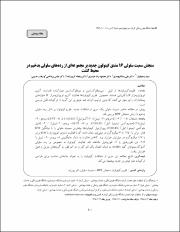| dc.contributor.author | Rajabalian, S | en_US |
| dc.contributor.author | Foroumadi, A.R | en_US |
| dc.contributor.author | Heidari, M.R | en_US |
| dc.contributor.author | Karimzadeh, R | en_US |
| dc.contributor.author | Pardakhti, A | en_US |
| dc.contributor.author | Hosseini, R | en_US |
| dc.date.accessioned | 1399-07-09T03:49:36Z | fa_IR |
| dc.date.accessioned | 2020-09-30T03:49:36Z | |
| dc.date.available | 1399-07-09T03:49:36Z | fa_IR |
| dc.date.available | 2020-09-30T03:49:36Z | |
| dc.date.issued | 2007-03-01 | en_US |
| dc.date.issued | 1385-12-10 | fa_IR |
| dc.date.submitted | 2016-08-12 | en_US |
| dc.date.submitted | 1395-05-22 | fa_IR |
| dc.identifier.citation | Rajabalian, S, Foroumadi, A.R, Heidari, M.R, Karimzadeh, R, Pardakhti, A, Hosseini, R. (2007). In Vitro Cytotoxicity Evaluation of Sixteen New N-Piperazinyl Quinolone Derivatives Against A Panel Of Tumor Cell Lines. Journal of Kerman University of Medical Sciences, 14(2), 100-108. | en_US |
| dc.identifier.issn | 1023-9510 | |
| dc.identifier.issn | 2008-2843 | |
| dc.identifier.uri | http://jkmu.kmu.ac.ir/article_17404.html | |
| dc.identifier.uri | https://iranjournals.nlai.ir/handle/123456789/248810 | |
| dc.description.abstract | Introduction: Fluoroquinolones are potent inhibitors of bacterial topoisomerase II. They can also inhibit eukaryotic topoisomerase, and may confer antitumoral properties. Method: In this study the antitumoral activity of a new series of N-substituted piperazinylfluoroquinolones against a panel of human tumor cell lines was determined by MTT assays. Results: Among the tested compounds N-[2- (5-bromo-2-thienyl)-2-oxoethyl ] (C1,N1,E1), N-[ 2- (5-bromo-2-thienyl)-2-(hydroxyimino) ethyl]( C2,N2,E2) and N-[2-(5-bromo-2-thienyl)-2- (phenylmethoxyimino) ethyl] (C3,N3,E3) piperazinyl quinolones exhibited the most cytotoxic activities (mean IC50s = 2.5 to 3 µg/ml), comparable to that of the Etoposide (mean IC50= 1.7µg/ml). Replacement of the 5- bromo-2-thienyl with 4- fluorophenyl or 2,6- difluorophenyl rings leads to variable inhibition activity. The quinolone activity was enhanced by the presence of a chlorine and two fluorine atoms at the benzyl and phenyl groups, especially against ACHN renal adenocarcinoma cell line. Conclusion: These data suggest that these series of quinolones provide good models for the further design of potent antitumor compounds. | en_US |
| dc.format.extent | 192 | |
| dc.format.mimetype | application/pdf | |
| dc.language | English | |
| dc.language.iso | en_US | |
| dc.publisher | Kerman University of Medical Sciences | en_US |
| dc.relation.ispartof | Journal of Kerman University of Medical Sciences | en_US |
| dc.subject | Cytotoxicity | en_US |
| dc.subject | Fluoroquinolone | en_US |
| dc.subject | MTT- assay | en_US |
| dc.subject | Etoposide | en_US |
| dc.title | In Vitro Cytotoxicity Evaluation of Sixteen New N-Piperazinyl Quinolone Derivatives Against A Panel Of Tumor Cell Lines | en_US |
| dc.type | Text | en_US |
| dc.type | Original Article | en_US |
| dc.contributor.department | Researcher, Kerman Neuroscience Research Center, Kerman University of Medical Sciences, Kerman, Iran | en_US |
| dc.contributor.department | Associate
Professor of Pharmaceutics, School of Pharmacy, Tehran University of Medical Sciences, Tehran, Iran | en_US |
| dc.contributor.department | Professor of
Pharmacology, School of Pharmacy, Kerman University of Medical Sciences, Kerman, Iran | en_US |
| dc.contributor.department | Pharmacist | en_US |
| dc.contributor.department | Assistant Professor of
Pharmacology, School of Pharmacy and Pharmaceutical Technology Research Center, Kerman University of Medical Sciences,
Kerman, Iran | en_US |
| dc.contributor.department | Researcher, Kerman Neuroscience Research Center, Kerman University of Medical Sciences, Kerman, Iran | en_US |
| dc.citation.volume | 14 | |
| dc.citation.issue | 2 | |
| dc.citation.spage | 100 | |
| dc.citation.epage | 108 | |





